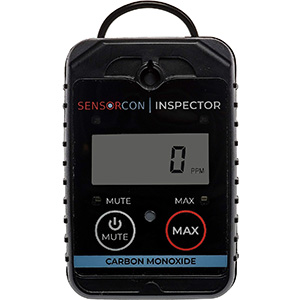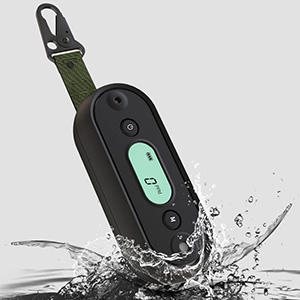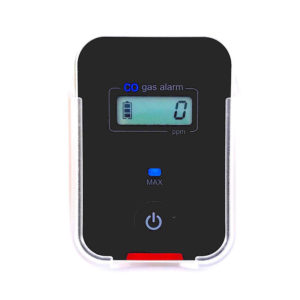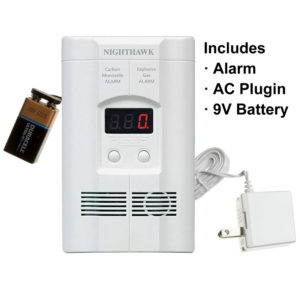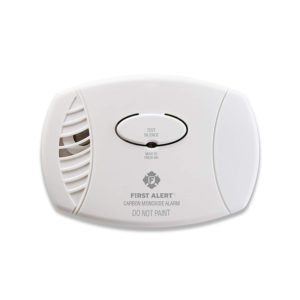Safe Travels With a Carbon Monoxide Detector
If you’re here reading this, you’re probably already aware of a number of high profile carbon monoxide poisoning deaths at hotels and Airbnbs. It seems like there’s a tragic news story every month covering deaths from carbon monoxide poisoning. They’re often–but not always–in international destinations. Because carbon monoxide (CO) can be released by malfunctioning equipment like furnaces and swimming pool heaters, hotels in the US aren’t necessarily any safer if they don’t have CO detectors in every room.
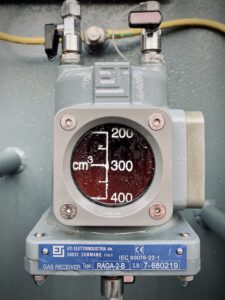
Carbon monoxide is a colorless and odorless gas, meaning that a detector is necessary to be alerted to CO buildup. It’s scarily easy to fall victim to carbon monoxide poisoning, but also easy to protect yourself.
While some Airbnbs and many hotels do have carbon monoxide detectors, not all do (and those that do might not be functional!). Smoke detectors are more common, and they DO NOT detect CO (this is important to take note of at home too!). I strongly recommend buying a detector for your travels. They’re easily packable and available in a wide budget range.
Here’s 6 small, portable carbon monoxide detectors to consider when traveling. Quick shop the widget below, or scroll down to read more about how carbon monoxide detectors work and to see detailed info on the detectors we recommend. Click here to jump down to FAQs about carbon monoxide poisoning and how experts recommend staying safe.
Stay Safe with Science: How Carbon Monoxide Detectors Protect Travelers in Hotels and Airbnbs
When you embark on a journey, the last thing you want is a hidden danger spoiling your adventure. Enter carbon monoxide (CO) – a colorless, odorless gas that can silently wreak havoc on your health. But fear not, fellow explorers! With the help of portable carbon monoxide detectors, you can keep this sneaky menace at bay and enjoy your travels with peace of mind.
Understanding the Science of Carbon Monoxide:
Before we dive into how these life-saving devices work, let’s grasp the science behind carbon monoxide. This toxic gas forms when fuel like gas, wood, or oil is burned incompletely. Faulty heating systems, blocked chimneys, or malfunctioning gas appliances are common culprits for CO production. When inhaled, CO molecules bind to our blood cells more tightly than oxygen, leading to reduced oxygen transport in our bodies. This can result in dizziness, nausea, headaches, and even fatal consequences in severe cases.
How Carbon Monoxide Detectors Work:
Carbon monoxide detectors serve as vigilant guardians against this invisible foe. These clever devices function based on chemical reactions involving CO molecules and specific sensors. Inside the detector, there are electrodes immersed in a gel that reacts with CO. When CO enters the detector, it reacts with the gel, generating an electric current. This current triggers the alarm, alerting you to the presence of carbon monoxide.
The Threat of Carbon Monoxide Poisoning in Hotels and Airbnbs:
Hotels and vacation rentals may seem like safe havens, but carbon monoxide can pose a hidden threat in these accommodations. Faulty or poorly maintained heating systems, gas leaks, or even a neighboring room’s faulty appliance can introduce CO into shared spaces. As travelers, we might not be aware of the potential dangers lurking behind the walls of these temporary abodes.
The Portable Carbon Monoxide Detector as Your Travel Guardian:
This is where the portable carbon monoxide detector steps in to safeguard your well-being. These compact devices are designed for travelers seeking reassurance and protection during their trips. Before you settle in, simply unpack your portable CO detector and place it strategically in your room. It will diligently monitor the air for any signs of CO presence, allowing you to relax and enjoy your stay without worry.
What to look for in a Travel Carbon Monoxide Detector
All of our picks should work well for most travelers, but here’s a few things to consider when choosing a portable CO detector:
First off, how much space do you want to allocate? Smaller, handheld detectors can easily slip into a small purse, but generally come with a higher price tag.
You’ll also want to think about how you’ll power your carbon monoxide detector. Remember that lithium batteries can’t be placed in checked bags, and if you’re thinking about a detector that can be plugged in, make sure it’s compatible with the power and plug situation is in the country you’ll be traveling to (see advice on plug adapters here!).
Lastly, how important is a digital display to you? Will you feel more comfortable knowing the exact CO levels, or are you fine knowing that your device will alarm if it detects dangerous levels?
Final Thoughts
Before setting off on your journey, ensure your portable CO detector is in top-notch working condition. Check the batteries, familiarize yourself with the device’s features, and follow the manufacturer’s instructions to optimize its performance.
Traveling should be a time of joy and exploration, not one marred by unforeseen hazards. Armed with the science of carbon monoxide detectors, and the knowledge of potential risks, you can now prioritize your safety with confidence. So, next time you pack your bags for a hotel stay or an Airbnb adventure, make sure to bring along your trusty portable carbon monoxide detector – the guardian of your well-being and the key to unlocking a truly worry-free travel experience!
1. Sensorcon Inspector 2 CO Carbon Monoxide Monitor with Visual and Audible Alerts
Sensorcon’s small, portable CO monitor is a true pro device, designed for commercial and industrial applications. It’s a favorite of truckers and pilots who want to monitor carbon monoxide levels while working and sleeping. This detector has a blinking visual alert, audible alert, and a real-time carbon monoxide display from 1 to 1,999 ppm. It will sound a low level alert at 35 ppm and high level alert at 200 ppm.
At just 4.2 ounces, and 3.2 x 2.2 inches, it’s extremely easy to slip into a purse, backpack or carry-on. Those who utilize this detector for work will even comfortably wear it on a lanyard!
2. HAOKESITE Carbon Monoxide Detectors Plug in Wall Portable Carbon Monoxide Detector
This reasonably priced CO detector from Haokesite is perfect if you don’t want to mess with batteries, and know you’ll have consistent access to plugs and power supply. I like having a digital display, so it’s very clear what the levels are. The display shows levels in real time, and when the CO concentration is 150PPM and 85 decibel alarm will sound the visual light alarm will blink.
3. GZAIR Travel Carbon Monoxide Detector
Gzair’s eminently portable lanyard CO detector can be clipped onto a backpack or easily slipped into your luggage. At 4.3 x 1.8 x 1.3 inches and just 4.4 ounces, it won’t weigh you down or take up much space. The digital display shows real time CO concentration levels, and features visual, audio and vibration alarms. The 90 decibel alarm has two different levels, and starts at 50PPM.
4. Forensic Detectors Hand Held Carbon Monoxide Detector
This small, handheld detector is extremely sensitive, alarming faster, and at lower CO concentrations than other sensors. It small enough to toss in a purse, so even when traveling carry-on only, I don’t feel tempted to leave it at home.
I love the clear screen showing battery level and CO level. When triggered, the bright red LED light turns on, and a 70 decibel buzzer sounds. The easy to use design makes it my top pick– and this is the detector that I carry when I travel.
5. Nighthawk Plug-in Carbon Monoxide Alarm
Nighthawk’s great CO alarm is a tad larger than some of the other picks, but it’s affordable and has the advantage of being powered by battery or plug. Even when plugging in, it’s nice to have the battery backup in the event of a power outage. And with the six foot cord, you shouldn’t have any trouble finding a spot to plug in.
The digital display clearly shows carbon monoxide levels, a small blinking light indicates it’s functioning, and when triggered, a loud 85 decibel alarm sounds.
6. First Alert Carbon Monoxide Detector Alarm
There’s actually no reason why you can’t bring along the same type of CO detector you use at home! First Alert’s affordable model is small enough to easily pack, and works pretty much as you’re probably used to from home or apartment detectors.
Like the Nighthawk, it’s plug in with a battery backup, though there’s no cord.
This First Alert model does not have a digital display, but there’s a test button, and the unit will chirp to let you know when the battery is low. When triggered, the 85 decibel alarm sounds.
FAQs About Traveling with a Carbon Monoxide Detector:
Carbon Monoxide is a colorless, odorless and tasteless gas that often comes from improperly installed or maintained gas burning devices. Many buildings use gas for heating and cooking. However, CO can also build up from the burning of wood, oil or gasoline.
CO kills by inhibiting the blood’s ability to carry oxygen. Symptoms of CO poisoning include headache, nausea, drowsiness, and confusion. However, many people who die of carbon monoxide poisoning, die in their sleep, without the opportunity to recognize the symptoms and escape. This is why having a CO detector is so important, especially when you travel, and have less knowledge of and control over safety measures taken in your lodging!
The EPA recommends that alarms should be installed on each level of a house, at least 5 feet above the floor. You can place an alarm in each bedroom, but if that’s not feasible, the alarm should be placed in the hallway as close as possible to the sleeping areas.
One CO detector should be fine for most hotel rooms, but if you’re traveling with a large party and staying in separate rooms, ensure that each room has their own detector.
You should leave the hotel room or Airbnb immediately. Even if you’re not experiencing any symptoms of CO poisoning, it’s better to err on the side of safety.
When staying at a hotel, go to the lobby and insist that they call the fire department or appropriate local agency to have the room checked. If you feel fuzzy headed or otherwise ill, request that the hotel summon medical assistance, and go outside for fresh air.
If staying at a vacation rental, leave the apartment or house immediately. Don’t just leave the room in which the alarm went off, go outside the building into fresh air. Call the fire department yourself to have the home checked, and request medical assistance if you feel ill. Airbnb and other rental platforms do want to know as soon as possible if you experience any problems, so give a call them when you’re able to, and give the host a heads-up about the issue as well.
If it seems like a hotel or vacation rental is not taking the situation seriously, don’t be bullied into returning to a room you feel unsafe in. Be sure to take notes and names, and if at all possible, simply switch lodgings. With enough documentation, you may be able to file a chargeback on your credit card for the original accommodations.
You shouldn’t have any issues traveling with a carbon monoxide alarm in either your checked or carry-on bag. There is one caveat here: you should not put lithium batteries in a checked bag. So if your CO detector is powered by lithium batteries, you’ll need to pull the batteries out, and place them (or the entire detector) in your carry-on.
These two detectors alert you to the presence of different, separate dangers. A carbon monoxide detector will sound the alarm only in the presence of carbon monoxide, an odorless, colorless gas. A smoke detector alarms when it detects smoke particles from a fire–or as often happens in our household, because we produced a little smoke while cooking. Homes and apartments commonly have smoke detectors, however carbon monoxide detectors are less common. While dual-purpose detectors do exist, smoke detectors DO NOT detect carbon monoxide, and carbon monoxide detectors DO NOT detect smoke.
Sources:
CDC – Carbon Monoxide Poisoning
Airbnb – What should I know about fire and carbon monoxide safety when I travel?
CBS News – What to know about carbon monoxide safety before booking an Airbnb or hotel
Bloomberg – Death of Brazilian Tourists Adds to Airbnb Problems in Chile
PubMed – Carbon monoxide poisoning at motels, hotels, and resorts
Forbes – Hotels: A Hidden Source of Carbon Monoxide Poisoning
The Guardian – Seven in critical condition after Ohio hotel carbon monoxide poisoning

